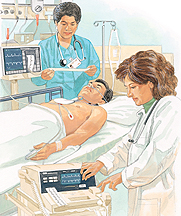Cardioversion
Cardioversion
Cardioversion is a procedure to restore your heart’s normal rhythm from a fast or irregular rhythm (arrhythmia) in the top or bottom chambers of your heart. You may have the procedure in a hospital or surgery center. It’s often done on an outpatient (same day) basis. During the procedure, your doctor will give you medication to minimize discomfort. Then the doctor gives you a brief electric shock. This helps your heartbeat become normal again. In most cases, you can go home within hours of the procedure.
 Before Your Procedure
Before Your Procedure
Tell your doctor what over-the-counter and prescription medications, herbs, and supplements you are taking.
Take medication as directed. Your doctor may prescribe anticoagulants (blood thinners), depending on your situation. They help prevent blood clots from forming. Your doctor may order an ultrasound called transesophageal echocardiography. This will help your doctor figure out if you need a blood thinner.
Ask your doctor about the risks and benefits of cardioversion.
Sign your consent form.
Don’t eat or drink anything for 8 to 12 hours before your procedure.
Follow any other instructions your doctor gives you.
Arrange for an adult to drive you home after the procedure.
During Your Procedure
Your health care provider will place small pads (electrodes) on your chest to record your heartbeat at all times.
Your health care provider will place an intravenous (IV) line in your arm. This gives you medication (sedation) that keeps you free of pain. You’ll feel sleepy.
Your health care provider will give you oxygen through a soft, plastic tube in your nose.
Pads will be placed on your chest and back. Your health care provider will give you a very brief electric shock through the pads. Remember, because of sedation, you won’t feel the shock.
Your doctor will watch your heartbeat to make sure your normal rhythm has been restored.
After Your Procedure
Your health care provider will monitor you until you are fully awake. Then you’ll be able to sit up, walk, and eat.
In most cases, you’ll be able to go home after the sedation wears off. This usually takes a few hours.
For a few days, the skin on your chest may feel a little sore, like a mild sunburn.
Don’t drive or operate heavy machinery for 24 hours after the procedure.
The day after your procedure, try to take it easy. Take medication as directed.
Call your doctor if you notice skipped beats, a rapid heartbeat, or chest tightness. These may be signs that an irregular heartbeat has returned.
Updated:
March 21, 2017
Sources:
Part 6: Electrical Therapies: Automated External Defibrillators, Defibrillation, Cardioversion, and Pacing. 2010 American Heart Association Guidelines. Link, ML. Circulation. 2010;122(3):s706-19.
Reviewed By:
Fincannon, Joy, RN, MN,MMI board-certified, academically affiliated clinician,Pierce-Smith, Daphne, RN, MSN, CCRC